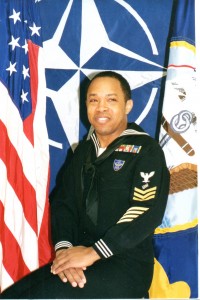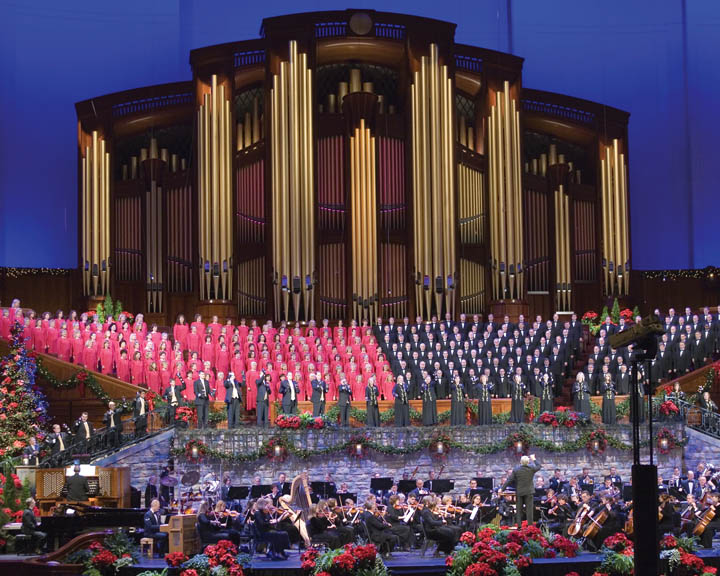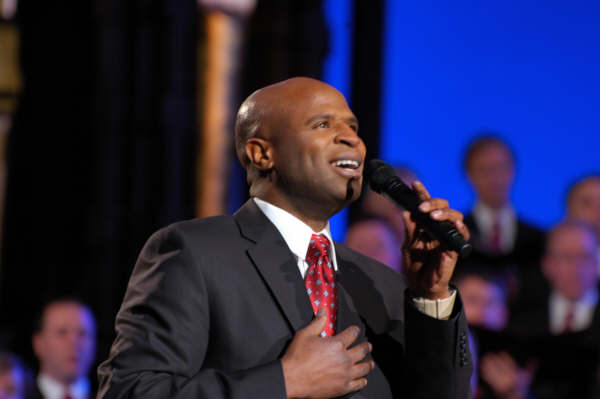 Keith L. Brown is a convert to The Church of Jesus Christ of Latter-day Saints and serves as the Ward Mission Leader in the Annapolis, Maryland Ward.
Keith L. Brown is a convert to The Church of Jesus Christ of Latter-day Saints and serves as the Ward Mission Leader in the Annapolis, Maryland Ward.
Mormonism’s Sacred Voice is America’s Choir
After singing the sacred hymns of The Church of Jesus Christ of Latter-day Saints (sometimes inadvertently called the “Mormon Church”) for more than a century and a half, the Mormon Tabernacle Choir has become popularly known as “America’s Choir.” The 360 member choir is comprised of men and women ranging from ages 25 to 60 from many diverse backgrounds and professions whose incomparable voices combine together to create a harmonious melody brought about by their love for singing and their faith in the Lord Jesus Christ.
 Founded in August 1847, one month after the Mormon pioneers entered the Salt Lake Valley, the Mormon Tabernacle Choir has appeared at 13 world’s fairs and expositions, performed at the inaugurations of five United States Presidents – Lyndon B. Johnson (1965), Richard M. Nixon (1969), Ronald Reagan (1981), George Bush (1989), and George W. Bush (2001) – and sung for numerous worldwide telecasts and special events. Five of the Choir’s recordings have achieved “gold record” and two have achieved “platinum record” status. Their most popular recording was the 1959 release of “The Battle Hymn of the Republic” recorded with Eugene Ormandy and the Philadelphia Orchestra, which won a Grammy award for Richard P. Condie, who was the conductor of the Choir at that time.
Founded in August 1847, one month after the Mormon pioneers entered the Salt Lake Valley, the Mormon Tabernacle Choir has appeared at 13 world’s fairs and expositions, performed at the inaugurations of five United States Presidents – Lyndon B. Johnson (1965), Richard M. Nixon (1969), Ronald Reagan (1981), George Bush (1989), and George W. Bush (2001) – and sung for numerous worldwide telecasts and special events. Five of the Choir’s recordings have achieved “gold record” and two have achieved “platinum record” status. Their most popular recording was the 1959 release of “The Battle Hymn of the Republic” recorded with Eugene Ormandy and the Philadelphia Orchestra, which won a Grammy award for Richard P. Condie, who was the conductor of the Choir at that time.
Performing live from Temple Square in Salt Lake City, the Mormon Tabernacle Choir can be heard weekly on the broadcast of the longest-running network radio program in the world, Music and the Spoken Word. On 16 July 1989, CBS Radio acclaimed the Mormon Tabernacle Choir’s unprecedented sixtieth year of continuous weekly performances. On the occasion of the Choir’s 3,000th broadcast in 1987, John Burrows, Vice President of the CBS Radio Network, wrote: “The chances of a program that started on a national network in 1929 still being broadcast … are very, very slim. But you have done it. In fact, you’re the only ones to have done it.” It is also of noteworthy interest that neither CBS nor any of the other stations worldwide that carry the broadcast make money by selling air time to the Choir. Instead, the millions of dollars of air time are donated as a public service.
Literally millions of people enjoy the melodic sounds of the Mormon Tabernacle Choir each week. Tabernacle Choir programs are carried on approximately 450 radio stations in the United States and Canada and are broadcast on radio and television stations in some countries of Europe and the South Pacific. Via the Armed Services Radio Network, the Choir is also carried into twenty-two countries. The program is recorded live by KSL Television in Salt Lake City Utah and then aired on a one-week delayed basis on more than 280 television/cable systems (the number increases weekly) in the United States and Canada.
As unlikely as it may seem, this nonprofit group of volunteer singers has truly become a superstar sensation in the music industry and entertainment world. The Choir has produced more than one hundred albums, five of them “gold”—signifying that more than 500,000 copies have been sold. It is interesting to note that only seventeen “gold” albums have ever been earned in classical music. In addition, the Choir performs annual concerts, not only in Salt Lake City and other parts of the United States, but throughout the world. It has performed to packed audiences in some of the world’s greatest concert halls in eighteen countries. Tabernacle Choir concerts, featuring internationally famous guest artists, such as David Archuleta of American Idol fame for the 2010 Christmas concert, are recorded and later broadcast as major television specials around the world.
Members of The Church of Jesus Christ of Latter-day Saints love their choir as well. Yet, if there is any criticism given of the Choir, it generally comes from Church members. The most common criticism or complaint is about the Choir’s musical repertoire. Some members feel it’s too classical; others say it’s too secular. Some feel the Choir should sing more hymns; others prefer more contemporary LDS music. The spoken portion of the weekly radio broadcasts also has its critics, mostly from a few Church members who feel that its content is too generic. They feel that it should be more specific and unique to LDS doctrines and beliefs.
Speaking to this subject, Jerold D. Ottley, director of the Choir from 1974 to 1999, said, “I realize there are members of the Church who do not understand that the Choir has a specific mission to the world, nor do they comprehend the enormous good the Choir does out there for the reputation of the Church. The Choir works under the direct supervision of the First Presidency, and our repertoire and daily operations keep pace with that direction.”
 When listening to the broadcast of Music and the Spoken Word, listeners need to keep in mind that they are listening to a program of inspiration, not a Sunday-morning worship service. The Sunday-morning repertoire is chosen by the Music Director, Mack Wilberg, and the organists on a more eclectic basis. Given that people in most countries are familiar with classical works, music may be chosen from such great composers as Bach, Mendelssohn, or Handel. Secular selections may be chosen from Broadway musicals, traditional spirituals such as Alex Boye‘ (a member of the Choir who also has his own musical career) leading the Choir in a rising rendition of “Rock My Soul in the Bosom of Abraham”, nostalgia, or folk music. And sacred selections are selected that appeal to both LDS and non-LDS audiences. Music often appears on the broadcast in preparation for other events that the Choir will be a part of.
When listening to the broadcast of Music and the Spoken Word, listeners need to keep in mind that they are listening to a program of inspiration, not a Sunday-morning worship service. The Sunday-morning repertoire is chosen by the Music Director, Mack Wilberg, and the organists on a more eclectic basis. Given that people in most countries are familiar with classical works, music may be chosen from such great composers as Bach, Mendelssohn, or Handel. Secular selections may be chosen from Broadway musicals, traditional spirituals such as Alex Boye‘ (a member of the Choir who also has his own musical career) leading the Choir in a rising rendition of “Rock My Soul in the Bosom of Abraham”, nostalgia, or folk music. And sacred selections are selected that appeal to both LDS and non-LDS audiences. Music often appears on the broadcast in preparation for other events that the Choir will be a part of.
Likewise, the spoken portion of the Sunday-morning broadcast is not intended to be a forum for proselytizing. The “Spoken Word” was developed in 1930 by Richard L. Evans, who later became a member of the Quorum of the Twelve Apostles and who was the Choir’s announcer for forty-one years, as a three-minute sermonette on Christian thought. The same format is now used by Lloyd D. Newell, the Choir’s current announcer. He is careful that the pieces address a general religious audience and deal with universal principles and concerns.
The Mission of the Mormon Tabernacle Choir
The Mormon Tabernacle Choir’s mission is basically two-fold: (1) to be a missionary, with a special calling to reach out to the world, and (2) to be an ambassador for the Church, with a charge to bring credibility and goodwill to the Church in all areas of the world. The objective of the Mormon Choir is to warm people’s hearts, rather than to warn them. President Gordon B. Hinckley often told the Choir that, except for the Book of Mormon, there is no greater missionary for the Church than the Tabernacle Choir. Wendell Smoot, former President of the Choir, once said, “The Choir is the band that leads the parade, as far as the public relations image of the Church is concerned. Wherever we go in the world, literally everywhere, people know us. They associate the Choir with that which is good, wholesome, and uplifting.”
Throughout the years of their dedicated service the Choir has become something of an unofficial ambassador for the United States as well. On the occasion of the Choir’s 3,000th radio broadcast, Ronald Reagan, then President of the United States, sent a letter to the Choir in which he identified the Tabernacle Choir as “an inspiring American landmark of musical achievement. For many years, the choir has been a source of pride not only to its Church sponsors but to all Americans. It has become an esteemed part of the cultural life of our nation, combining outstanding musicianship with dedicated service to God.”
Additional Resources:
Mormon Tabernacle Choir Official Website
Basic Mormon Beliefs and Real Mormons
